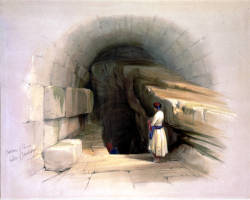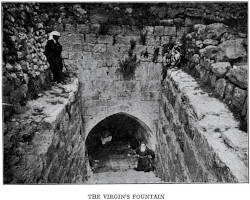מעיין הגיחון
Gihon Spring - Fountain of the Virgin - Saint Mary’s Pool
Useful Information
| Location: |
(31.773792, 35.236965) |
| Open: |
no restrictions. [2021] |
| Fee: |
free. [2021] |
| Classification: |
 Karst Spring Karst Spring
 Intermittent Spring Intermittent Spring
|
| Dimension: | |
| Guided tours: | self guided |
| Photography: | allowed |
| Accessibility: | no |
| Bibliography: | |
| Address: | |
| As far as we know this information was accurate when it was published (see years in brackets), but may have changed since then. Please check rates and details directly with the companies in question if you need more recent info. |
|
History
| 1880 | Siloam inscription discovered. |
| 1948 | spring poisoned with typhus and diphtheria bacteria as part of a biological warfare strategy. |
| 2009 | fragment of a monumental stone inscription dated to the 8th century BCE discovered. |
| 2017 | study by the Weizmann Institute of Science. |
Description


מעיין הגיחון (Gihon Spring) was the most important source of water in the City of David, before Jerusalem was conquered by the Romans. At that time it was an intermittent spring, it used to flow three to five times daily in winter, twice daily in summer, and only once daily in autumn. Nevertheless, it has the largest output of water in the area, 600,000 m³ per year. And the strange behaviour was probably the source of the name, the Hebrew Giha means gushing forth. It is also named Fountain of the Virgin and Saint Mary’s Pool after the legend that here Mary washed the swaddling clothes of Jesus.
The spring rises in a small cave, which is only 6 m by 2 m in size. As it allowed the early settlement by providing drinking and irrigation water, it was quite important from the early days. The first alterations to allow easier access were made in the Middle Bronze Age, others during the Iron Age. The entrance was widened, a staircase was built, also a building covering the entrance to the spring. The water was collected in the Pool of Siloam which is located 535 m to the south. So the pool was the buffer providing water around the clock, and was refilled by the spring when it was flowing. The pool was rather big and allowed to store a large amount of water needed for the town.
Today the spring is not flowing anymore, modern pumping of groundwater lowered the water table. The site is open to the public, but without water and as it is quite small, it is not very popular.
 Search DuckDuckGo for "Gihon Spring"
Search DuckDuckGo for "Gihon Spring" Google Earth Placemark
Google Earth Placemark Gihon Spring - Wikipedia (visited: 28-OCT-2022)
Gihon Spring - Wikipedia (visited: 28-OCT-2022) Index
Index Topics
Topics Hierarchical
Hierarchical Countries
Countries Maps
Maps